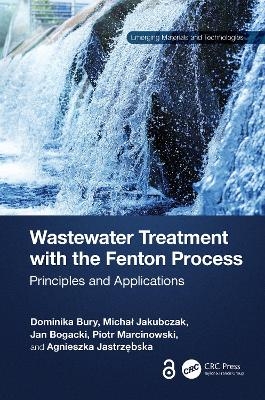
Wastewater Treatment with the Fenton Process
CRC Press (Verlag)
978-1-032-35901-4 (ISBN)
The presence of refractory organic compounds in wastewater is a global problem. Advanced oxidation processes, in general, and the Fenton oxidation process are alternative technologies for wastewater and water treatment. This book gives an overview of Fenton process principles, explains the main factors influencing this technology, includes applications, kinetic and thermodynamic calculations and presents a strong overview on the heterogeneous catalytic approach. It demonstrates that the iron-based heterogeneous Fenton process, including nanoparticles, a new complex solution, is highly efficient, environmentally friendly and can be suitable for wastewater treatment and industrial wastewater.
FEATURES
Describes in detail the heterogeneous Fenton process and process applications
Analyzes the advantages and disadvantages of different catalysts available and their suitability to specific processes
Provides economic analysis of the Fenton process in a ready-to-use package for industrial practitioners for adaptation into already existing industrially viable technologies
Promotes a modern solution to the problem of degradation of hazardous compounds through ecological and environmentally friendly processes and the use of a catalyst that can be recycled
Explains highly complex data in an understandable and reader-friendly way
Intended for professionals, researchers, upper-level undergraduate and graduate students in environmental engineering, materials science, chemistry, and those who work in wastewater management.
Chapters 3, 4, and 9 of this book are freely available as a downloadable Open Access PDF at http://www.taylorfrancis.com under a Creative Commons Attribution-Non Commercial-No Derivatives (CC-BY-NC-ND) 4.0 license.
Dominika Bury is a PhD student at the Warsaw University of Technology (WUT), Faculty of Materials Science and Engineering, Department of Ceramic and Polymer Materials. Her research focuses on the efficiency of the heterogeneous Fenton process with iron catalysts in degradation cosmetic wastewater. Michał Jakubczak is a PhD student at the Warsaw University of Technology (WUT), Faculty of Materials Sciences and Engineering, Department of Ceramic and Polymer Materials. His research focuses on ecotoxicology and antibacterial properties of 2D nanomaterials, mostly MXenes. Jan Bogacki, PhD, is an assistant professor in the Department of Informatics and Environmental Quality Research, Faculty of Building Services, Hydro, and Environmental Engineering at the Warsaw University of Technology (WUT). He earned a PhD at the Warsaw University of Technology and is the author of 50 scientific publications. Piotr Marcinowski, PhD, is an assistant professor in the Department of Informatics and Environmental Quality Research, Faculty of Building Services, Hydro, and Environmental Engineering at the Warsaw University of Technology (WUT). He earned a PhD in 2002 at the Warsaw University of Technology and is the author of 40 scientific publications. Agnieszka Jastrzębska, PhD, DSc, is a professor at the Warsaw University of Technology (WUT). She leads an interdisciplinary research team at the Faculty of Materials Science and Engineering, Department of Ceramic and Polymer Materials. Her research concentrates on nanotechnology for bioactive materials with multifunctional hybrid nanocomposite structures.
1. Introduction. 2. Fenton Process Principles. 3. Catalysts. 4. Nanomaterials. 5. Application and Efficiency of the Process. 6. Factors Influencing the Effectiveness of the Process. 7. Reactors in the Heterogeneous Fenton Process. 8. Kinetics of the Process and Thermodynamical Aspects. 9. Toxicity of the Catalyst and Products Formed in the Process. 10. Reusability of Catalyst. 11. Economical Aspects and Hydrogen Production. 12. Perspective and Summary.
| Erscheinungsdatum | 13.12.2023 |
|---|---|
| Reihe/Serie | Emerging Materials and Technologies |
| Zusatzinfo | 8 Tables, black and white; 24 Line drawings, black and white; 4 Halftones, black and white; 28 Illustrations, black and white |
| Verlagsort | London |
| Sprache | englisch |
| Maße | 138 x 216 mm |
| Gewicht | 444 g |
| Themenwelt | Naturwissenschaften ► Biologie ► Biochemie |
| Naturwissenschaften ► Chemie ► Technische Chemie | |
| Technik ► Bauwesen | |
| Technik ► Umwelttechnik / Biotechnologie | |
| ISBN-10 | 1-032-35901-3 / 1032359013 |
| ISBN-13 | 978-1-032-35901-4 / 9781032359014 |
| Zustand | Neuware |
| Informationen gemäß Produktsicherheitsverordnung (GPSR) | |
| Haben Sie eine Frage zum Produkt? |
aus dem Bereich


